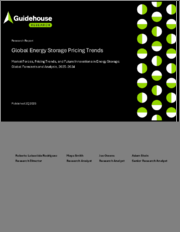
|
시장보고서
상품코드
1759953
세계의 에너지 저장 가격 동향 - 에너지 저장 시장 영향요인, 가격 동향, 향후 혁신 : 세계 시장 분석 및 예측(2025-2034년)Global Energy Storage Pricing Trends - Market Forces, Pricing Trends, and Future Innovations in Energy Storage: Global Forecasts and Analysis, 2025-2034 |
||||||
전기차(EV)의 급격한 성장, 재생에너지 보급 확대, 전력망 유연성 향상에 대한 요구가 증가함에 따라 전 세계적으로 배터리 에너지 저장 시스템(BESS)에 대한 수요가 빠르게 증가하고 있습니다. 이러한 움직임에 따라 주택, C&I(상업 및 산업), 유틸리티 분야에서 개발 사업자와 전력회사들은 BESS 도입을 확대하고 있습니다. 동시에 배터리 화학기술의 진화, 자동화, 시스템 통합의 고도화 등이 비용의 지속적인 하락에 기여하고 있으며, 특히 주류 기술인 리튬이온 시스템에서 그 추세가 두드러집니다.
그러나 앞으로의 전망은 과제를 안고 있습니다. 예를 들어, 미국에서는 규제의 불투명성과 관세의 영향으로 가격 하락 속도가 둔화되고 있습니다. 또한 전 세계적으로 공급과잉과 공급망 불안정성이 추가적인 비용 개선에 걸림돌이 될 수 있습니다.
본 보고서에서는 이러한 역학관계를 상세하게 분석하여 2034년까지 리튬이온 BESS의 가격 예측을 시나리오별로 제시합니다. 예측은 지역(미국, 유럽, 세계 시장), 고객 유형, 시스템 운영 시간별로 분류되어 있으며, 배터리 팩, 전력 변환 시스템(PCS), 설치 비용 등 구성 요소별 비용 내역도 상세하게 제시되어 있습니다.
또한, 리튬이온 외에도 나트륨이온(Na-ion) 배터리와 플로우 배터리와 같은 차세대 기술에 대한 이론적 분석을 통해 규모화 시 비용 경쟁력을 평가했습니다. 또한, 리튬이온의 가치사슬 구조를 다루며, 지역별 경쟁 환경, 수직적 통합 전략, 원자재 접근의 중요성이 장기적인 경쟁력에 어떤 영향을 미치는지 논의했습니다.
목차
제1장 주요 요약
- 서론
- 시장 예측
제2장 시장 문제
- 성장 촉진요인
- 기술 진보
- 경쟁 심화와 수직통합
- 리튬 가격 하락
- 장벽
- 미국의 규제와 관세
- 시장에의 신규 제조업체 참여
- 경쟁 격화에 의한 과잉 생산능력
- 가격
제3장 산업 밸류체인
- 리튬 이온 배터리 제조
- 지역 경쟁
- 수직 통합과 경쟁 역학
제4장 시장 예측
- 전제 및 조사 방법
- 예측 정의
- BESS 가격 세계 예측
- 유틸리티 규모
- 리튬이온 BESS 가격 지역별 예측
- 미국
- 유럽
제5장 결론 및 제안
- 3대 주요 포인트
- 제안
- 배터리 제조업체
- 최종사용자
- 미국 규제기관
제6장 두자어 및 약어 리스트
제7장 목차
제8장 도표
제9장 조사 범위, 정보원, 조사 방법 및 주석
LSH 25.07.09Global demand for battery energy storage systems (BESS) is accelerating, driven by the rapid growth of electric vehicles (EVs), increasing renewable energy penetration, and the need for greater grid flexibility. As a result, developers and utilities are scaling deployments across residential, commercial and industrial (C&I), and
utility-scale segments. At the same time, advances in battery chemistry, automation, and system integration are contributing to steady cost declines particularly for Li-ion systems, which remain the dominant technology.
However, the path forward is not without challenges. In the U.S., regulatory uncertainty and tariffs are slowing price reductions, while globally, overcapacity and supply chain volatility may limit further cost improvements. This report explores these dynamics in depth, providing scenario-based pricing forecasts for Li-ion BESS through 2034. Forecasts are segmented by region (U.S., Europe, and global markets), customer type, and system duration, with detailed breakdowns of cost components such as battery packs, power conversion systems, and installation.
In addition to Li-ion systems, the report includes a theoretical analysis of sodium-ion (Na-ion) and flow battery technologies, assessing their potential to compete on cost if scaled. It also examines the structure of the Li-ion value chain, highlighting regional competition, vertical integration strategies, and the role of raw material access in shaping long-term competitiveness. This report is designed to help stakeholders across the energy storage ecosystem understand pricing trends, evaluate investment opportunities, and navigate an increasingly complex market landscape.
Table of Contents
1. Executive Summary
- 1.1 Introduction
- 1.2 Market Forecast
2. Market Issues
- 2.1 Drivers
- 2.1.1 Technological Advances
- 2.1.1.1 LFP Adoption
- 2.1.1.2 Liquid Cooling Systems
- 2.1.1.3 Increased Cell and Container Size
- 2.1.1.4 Automation of BESS Production
- 2.1.1.5 Solid-State Batteries
- 2.1.2 Increased Competition and Vertical Integration
- 2.1.3 Declining Lithium Prices
- 2.1.1 Technological Advances
- 2.2 Barriers
- 2.2.1 U.S. Regulations and Tariffs
- 2.2.2 New Manufacturers in the Market
- 2.2.3 Overcapacity from Increased Competition
- 2.3 Pricing
3. Industry Value Chain
- 3.1 Li-ion Battery Production
- 3.1.1 Regional Competition
- 3.1.2 Vertical Integration and Competitive Dynamics
4. Market Forecasts
- 4.1 Assumptions and Methodology
- 4.2 Forecast Definitions
- 4.3 Global Forecasts for BESS Pricing
- 4.3.1 Utility Scale
- 4.4 Regional Forecasts for Li-ion BESS Pricing
- 4.4.1 U.S.
- 4.4.1.1 Residential
- 4.4.1.2 C&I
- 4.4.1.3 Utility Scale
- 4.4.1.3.1 1-Hour Duration
- 4.4.1.3.2 2-Hour Duration
- 4.4.1.3.3 4-Hour Duration
- 4.4.2 Europe
- 4.4.2.1 Utility Scale
- 4.4.1 U.S.
5. Conclusions and Recommendations
- 5.1 Three Big Takeaways
- 5.2 Recommendations
- 5.2.1 Cell Manufacturers
- 5.2.2 End Users
- 5.2.3 U.S. Regulators



















